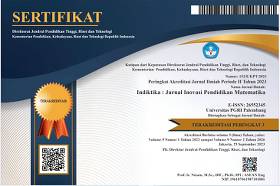Validity of PMRI-Based Geometry Teaching Materials for Elementary School Students
DOI:
https://doi.org/10.31851/indiktika.v6i2.15143Keywords:
validity, elementary school geometry, PMRIAbstract
This research aims to develop PMRI-based teaching materials on the elementary school geometry material that meets valid criteria. The research method used in this research is research-type development studies, with research carried out covering three stages: the preliminary stage, the prototyping stage, and the assessment stage. The technique of data collection using walk-through is done by providing teaching materials to experts, who then give comments as well as a mere view of each content, design, and language. Data analysis techniques are the result of a walk-through with experts analysed descriptively as input used to revise the teaching material, validation of the results of expert validation (expert review), and one-to-one results. The results of the development of PMRI-based teaching materials on the valid elementary school geometry materials are derived from the results of expert validation audits in terms of content, construction, and language and one-to-one audits.
References
Biber, C., Tuna, A., & Korkmaz, S. (2013). The Mistakes and the Misconceptions of the Eighth Grade Students on the Subject of Angles. European Journal of Science and Mathematics Education, 1(2), 50–59.
Bray, A., & Tangney, B. (2016). Enhancing Student Engagement Through the Affordances of Mobile Technology: a 21st century learning perspective on Realistic Mathematics Education. Mathematics Education Research Journal, 28, 173–197.
Ceria, R. E., Afgani, M. W., & Paradesa, R. (2022). Pengembangan Bahan Ajar Elektronik Berbasis Canva pada Materi Kubus dan Balok dengan Pendekatan PMRI Berorientasi Konteks Islam Melayu. JEMST (Jurnal of Education in Mathematics, Science, and Technology), 5(2), 82–94.
Elisyah, N., Zahra, A., & Astuti, W. (2023). Pembelajaran Segitiga dan Segiempat Berbasis Pendidikan Matematika Ralistik Indonesia (PMRI) dengan Konteks Kertas Origami. Jurnal Cendekia: Jurnal Pendidikan Matematika, 7(2), 1039–1049.
Gusnia, F., Sampoerno, D. P., & Santi, M. V. (2023). Pengaruh Pendekatan Pendidikan Matematika Realistik Indonesia Berbantuan Geogebra pada Pembelajaran Jarak Jauh terhadap Kemampuan Pemahaman Konsep Siswa. JRPMS (Jurnal Riset Pembelajaran Matematika Sekolah), 7(1), 62–72.
Haji, S. (2012). Model Bahan Ajar Matematika SMA Berbasis Realistic Mathematics Education untuk Mendukung Pencapaian Tujuan Pengajaran Matematika SMA di Provinsi Bengkulu. Pasundan Journal of Mathematics Education (PJME): Jurnal Pendidikan Matematika, 2(1), 1–23.
Kusumaningtyas, W. K. (2012). Penerapan PMRI Terhadap Kemampuan Pemecahan Masalah Matematika Berbantuan Alat Peraga Materi Pecahan. Unnes Journal of Mathematics Education, 1(2).
Muchlis, E. E. (2012). Pengaruh Pendekatan Pendidikan Matematika Realistik Indonesia (PMRI) terhadap Perkembangan kemampuan Pemecahan Masalah Siswa Kelas II SD Kartika 1.10 Padang. Jurnal Exacta, X(2), 136–139.
Mudaly, V., & Sukhdeo, S. (2015). Mathematics Learning in The Midst of School Transition from Primary to Secondary School. International Journal of Educational Sciences, 11(3), 244–252.
Mulbasari, A. S., Putri, R. I. I., Zulkardi, Z., & Aisyah, N. (2023). Analysis of the Needs of the PMRI Learning Environment for Geometry Material on the Critical Thinking Ability of PGSD Students. JTAM (Jurnal Teori Dan Aplikasi Matematika), 7(2), 273–282.
Naila, I., & Sadida, Q. (2020). Validitas Perangkat Pembelajaran Matematika Berbasis Scaffolding untuk Siswa Sekolah Dasar. PROCEEDING UMSURABAYA.
Plomp, T. (2013). Educational Design Research: an introduction. In T. Plomp & N. Nieveen (Eds.), Educational design research (pp. 10–51). Netherlands Institute for Curriculum Development (SLO), Enschede, the Netherlands.
Riyanti, T. (2022). Pengembangan Bahan Ajar Pertidaksamaan Linear Satu Variabel Berbasis PMRI Level HOTS di SMP. ELIPS: Jurnal Pendidikan Matematika, 3(2), 54–62.
Saragih, S., & Hutapea, N. M. (2022). Validitas Buku Ajar Mata Kuliah Geometri Berbasis Capaian Pembelajaran. Jurnal Penelitian Ilmu Pendidikan Indonesia, 1(2), 135–140.
Sari, N. (2017). Pengembangan Bahan Ajar Materi Persamaan Garis Lurus Berbasis Pendekatan Pendidikan Matematika Realistik Indonesia (PMRI). Jurnal Dosen Universitas PGRI Palembang.
Setiawan, H., Jamaris, J., Solfema, S., & Fauzan, A. (2022). Validitas Perangkat Pembelajaran Geometri Berbasis Etnomatematika Rumah Gadang. Jurnal Cendekia: Jurnal Pendidikan Matematika, 6(3), 3484–3494.
Shadiq, F. (2019). Pembelajaran Matematika (Cara Meningkatkan Kemampuan Berpikir Siswa). Graha Ilmu.
Simatupang, M. L. D., & Siregar, H. B. (2023). Bahan Ajar Interaktif Berbasis Pendekatan PMRI untuk Meningkatkan Kemampuan Pemecahan Masalah Matematis Siswa SMP. Blackboard Journal: Research Innovation In Mathematics Education, 1(1), 1–9.
Tessmer, M. (1993). Planning and Conducting Formative Evaluations. Taylor & Francis.
Utami, N. P. (2014). Kemampuan Penalaran Matematis Siswa Kelas XI IPA SMAN 2 Painan Melalui Penerapan Pembelajaran Think Pair Square. Jurnal Pendidikan Matematika, 3(1).
Van den Akker, J., Gravemeijer, K., & McKenney, S. (2006). Introducing Educational Design Research. In Educational design research (pp. 15–19). Routledge.
Wildan, Z. (2013). Dinamika Kelompok: Latihan kepemimpinan pendidikan. Bumi Aksara.
Downloads
Published
Issue
Section
License
Copyright (c) 2024 Anggria Septiani Mulbasari, Ratu Ilma Indra Putri, Zulkardi, Nyimas Aisyah

This work is licensed under a Creative Commons Attribution-ShareAlike 4.0 International License.
This work is licensed under a Creative Commons Attribution-ShareAlike 4.0 International License.
Authors who publish with this journal agree to the following terms:
- Authors retain copyright and grant the journal right of first publication with the work simultaneously licensed under a Creative Commons Attribution License that allows others to share the work with an acknowledgement of the work's authorship and initial publication in this journal.
- Authors are able to enter into separate, additional contractual arrangements for the non-exclusive distribution of the journal's published version of the work (e.g., post it to an institutional repository or publish it in a book), with an acknowledgement of its initial publication in this journal.
- Authors are permitted and encouraged to post their work online (e.g., in institutional repositories or on their website) prior to and during the submission process, as it can lead to productive exchanges, as well as earlier and greater citation of published work.












